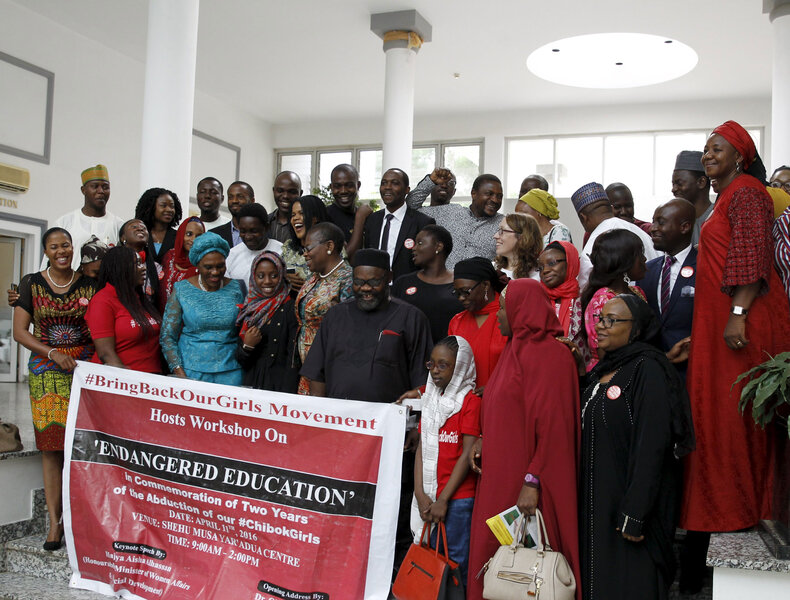Why Boko Haram's use of girls as suicide attackers has jumped
Loading...
As Boko Haram sharply boosts its use of girls as suicide bombers, it may be revealing a growing vulnerability to military pressure, experts say.
Boko Haram, an Islamic extremist group based in Nigeria, grabbed global attention two years ago when it abducted nearly 300 Nigerian schoolgirls in the town of Chibok. Now, it is upping the ante, sending 44 children last year on suicide missions against civilians in Nigeria, Cameroon, Chad, and Niger. That represented an 11-fold increase from 2014, according to a UNICEF report. The overall number of attacks across those countries rose from 32 to 151 in the same period.
The development is an unnerving step from a group that has shown its willingness to exploit children, particularly young girls, experts say. It is also keenly aware of the shock value of using children to commit violence. But Boko Haram may be deploying children against soft targets like local markets because the international coalition spearheaded by Nigerian President Muhammadu Buhari has become a harder target, and has had some success in liberating territory as well as captive women and children. And amid the gloomy statistics, there is evidence that young girls who have been radicalized or forced to carry out attacks can change course – even at the last minute.
“When these groups are losing – when they’re losing territory in particular – one of the ways to project that they’re relevant, they’re strong, they’re still a force with which to be reckoned, is to have these attacks,” says Mia Bloom, a professor of communication at Georgia State University and author multiple books on terrorism including, “Bombshell: Women and Terror.”
Professor Bloom adds that while Boko Haram is somewhat similar to the self-described Islamic State, which has also stepped its suicide attacks as it has lost territory, it stops short of tapping children to go after hard targets.
“Unlike ISIS, Boko has been targeting cellphone markets, chicken markets, places where civilians congregate,” she says,“the idea being that using the children against these targets is ideal because they fall under the radar screen. Nobody is going to be suspicious of an eight-year-old girl, a 10-year-old girl.”
President Buhari’s forces have had more success than his predecessor, Goodluck Jonathan, in beating back the territorial spread of Boko Haram and rescuing girls and women – not including the Chibok girls, according to Quartz. But since taking office in March 2015, he has fallen well short of ending the group’s insurgency by his ambitious December deadline, even though he announced at that time that Boko Haram had been “technically defeated,” an exaggerated claim that was followed by an escalation in suicide attacks.
The UNICEF report called the conflict with Boko Haram “one of the fastest growing displacement crises in Africa,” with more than 1.3 million children displaced, 1,800 school closures, and 5,000 children separated from their parents.
Boko Haram’s use of girls is precise, according to research by Bloom and her colleagues. They tend to use girls who are too young and women who are too old to bear children to carry out suicide attacks. Those in their teens to early 20s are generally given to Boko Haram fighters; 91 percent who are released from the group’s Sambisa Forest headquarters, are pregnant.
But even if the girls are released or escape, they face significant challenges, according to the UNICEF report. They are often seen as security threats, which has proven true on some occasions. Those born to women who’ve been with fighters also face stigma in “their villages, host communities or camps for internally displaced persons.”
Manuel Fontaine, UNICEF’s regional director for West and Central Africa, says the stigma is unjust.
“Let us be clear: these children are victims, not perpetrators,” Mr. Fontaine said. “Deceiving children and forcing them to carry out deadly acts has been one of the most horrific aspects of the violence in Nigeria and in neighboring countries,” he said in the statement accompanying the release of the report.
Despite the growing deployment of girls and women as suicide attackers, there have also been remarkable instances of girls deciding to abort suicide operations.
In one instance, reported by The New York Times’s Dionne Searcy, a girl sent to bomb a village in northern Cameroon dropped her explosives at the last moment and instead ran to authorities, to whom she gave information that led to a raid on Boko Haram.
In another, three girls were sent to bomb an internally displaced persons camp in northeastern Nigeria. Two detonated their explosives, killing 60 people, but the third, after glimpsing her parents among those fleeing, threw her explosives in the bush.






